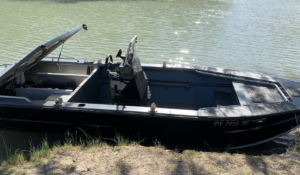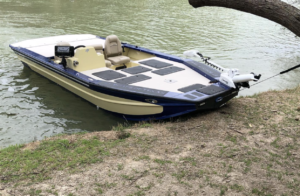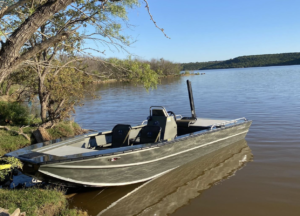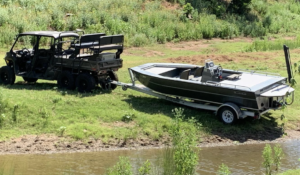River Jet Boats
River Jet Boats
A jet boat is a great way of enjoying water sports and recreation during summer. It uses a jet drive propulsion system for power, and is perfect for shallow waters as well as deep waters. Besides, they are fast and reliable and are not susceptible to damages that normal face other types of boat propeller systems.
Who Invented the Jet Boat?
The jet boat was invented by William Hamilton in the 1950s. He was trying to find a solution for boat propellers that work in the rocky shallow waters in his homeland. These rocky and shallow water were often a constrain to propellers, and used to destroy a lot of them preventing people from enjoying water recreation.
However, it was not until the 1970s that the jet boat began being used as a part of the American recreational boating experience with the development of water scooters which employed the use of jet boat propulsion technology. It was not until the early 1990s that Yamaha developed the first recreational jet boat, which opened the jet boat niche as a new style of water recreation.
How Does the Jet Boat Propulsion System Work?
 The jet boat propulsion system works through the use of a direct jet-propulsion system. It is relatively simple in comparison to other propulsion systems such as the sterndrive, outboard, and inboard.
The jet boat propulsion system works through the use of a direct jet-propulsion system. It is relatively simple in comparison to other propulsion systems such as the sterndrive, outboard, and inboard.
The direct jet-propulsion system works by connecting the engine shaft to the impeller which is housed in the jet-drive unit. It is contrary to the normal connection of the engine shaft to the propeller on a conventional power boat. By connecting the shaft to the impeller, it is now possible for the impeller to suck up large amounts of water through the screen protected intake point at the bottom of the boat. The water is the pumped out of the jet-drive unit by a pump and the impeller through a nozzle found below the waterline. The pump forces the water out of the nozzle at high speeds, which provides enough thrust to push the boat forward.
When the jet boat engines are turned on, they generate minimal jet thrusts that are output through the directional nozzles present at the stern of the boat. When the operator pushes the throttle lever forward, a jet thrust is generated resulting to the boat jumping up on plane. When the levels are put on neutral or reverse, a V-shaped bucket control unit is dropped down across the jet nozzles. The action redirects water flow from the boats nozzles towards the bow, either holding the boat in position in neutral mode, or pushing it back if on reverse mode.

The nozzles are the main areas of the jet boat engine the facilitate steering. Any action on the port to the starboard in done in an instance, and this gives the jet boat advanced agility. Think of this, traditional boat engines require at least two and a half steering (or six for the outboard engine) wheel revolutions to completely turn the boat to a desired direction due to the low-speed maneuvering. Furthermore, the reactions from the hard port to the hard starboard is slow. However, in a jet boat engine, you hardly require a revolution to do the same job (technically, you only need to turn the steering wheel around 270 degree to have turn).
Therefore, it is relatively easy to steer a jet boat even at high speeds because it requires less effort due to high functionality and coordination of the jet boat engine with the port board. It is essential for those used to traditional propellers to take some training with a low speed jet engine to prevent oversteering the jet boat especially at top speeds.
Advantages of a Jet Boat
1.Their Sizes Are Customizable
If you have some knowledge about watercrafts, you might know that most watercrafts are similar in styling and size. Commonly, they are anywhere between 8-12 inches, and are designed to carry 2-3 passengers. The engines are normally anywhere between 80-350 horsepower, which makes them lightweight and suitable for short distances and carry a lighter load. They can be termed as motorcycles on water.
 On the other hand, a jet boat is like a typical fiberglass runabout. They are bigger, more efficient, and have a higher horsepower in comparison to the other watercrafts. The typical span size of most jet boats in between 16-24 inches, with most just over 20 inches. Those below 20 inches often have one motor, while large ones have twin motors. Some models like the Chaparral Vortex 2430 VRX are designed with double high performance twin engines which generate a thrust of up to 500 horsepower.
On the other hand, a jet boat is like a typical fiberglass runabout. They are bigger, more efficient, and have a higher horsepower in comparison to the other watercrafts. The typical span size of most jet boats in between 16-24 inches, with most just over 20 inches. Those below 20 inches often have one motor, while large ones have twin motors. Some models like the Chaparral Vortex 2430 VRX are designed with double high performance twin engines which generate a thrust of up to 500 horsepower.
As seen above, jet boats have an advantage when it comes to the span size, and performance. Besides, due to the larger span size, it is easy to create a custom style that is unique to the boat owners taste and style. It is easy to customize the placement of different components of the jet boat engines, which is not possible with the traditional stern drive boat propulsion systems.
2.It Can Work in Shallow Waters
A jet boat doesn’t have a driveshaft or a prop, or an outdrive. All the components of the jet boat engines are housed in a jet-drive unit, which draws water in, then pumps it at higher speeds. It helps reduce the chances of injury on the propeller or shaft during operation especially in shallow or rocky water. That actually was the intention of Hamilton, the original inventor of this type of boat engine.
It means that it is possible to run the jet boat on shallow water of around 12 inches, or even less than 12 inches, although not recommendable, without risking damage to the jet-boat engine. The design of the jet boat also allows swimmers to swim around the jet engine without the risk of getting hurt or injured. It makes this type of propulsion system best, especially for areas with shallow water, rocks, or other water obstacles.
 3.They Have High Level Performance
3.They Have High Level Performance
Due to the strong engine design, and the ability to be customized, jet-boat engines generate a better thrust other boat propulsion systems such as the stern engine would not achieve. Jet boats are the leaders in water recreation due to the unmatched speeds of acceleration, and turning capacity. It is easy to accelerate and maneuver at top speeds due to the unique engine design. It makes them more desirable for top speed racing especially in shallow and rocky water with a lot of twists and turns.
4.They Are Safer
Traditional boat engine systems such as the prop engine have parts such as the propeller sticking out of the engine box. The prop in the prop engine majorly predisposes the boat to a high risk of accidents due to the spinning prop. It is easy for anyone around the boat engine to be injured by the propeller whether it is spinning or not. However, it is way much unsafe when it is spinning. It is easy to get caught up in the propeller which would easily cause injuries or death. Even when the motors are still, diving or swimming around such an engine would be hazardous. It is also possible to cause injuries and death too, which makes them pretty unsafe.
On the other hand, a jet-boat engine has interior propellers. It means that there is no risk in swimming or diving around the jet engine. The chances of an accident occurring are minimal. The engine does not pose a risk to anyone diving or swimming, making this type of engine the best for watercraft owners who have children. Your children are safe around the boat, and there is little chance of spin off injury to them. However, it is not ideal to be near a running jet boat engine due to the force generated to draw water into the engine. It can be dangerous to people especially children.
5.It is Ideal for Water Sports
In addition to the safety advantage, a jet boat is the best type of water craft for water sports. Due to the absence of a spinning propeller sticking out of the boat’s behind, this type of boat is great for wakesurfing. Wakesurfing is a fairly new watersport that is currently taking the water sporting world by storm. It entails using the wake found at he back of the boat to push a surfboard while standing on it without the use of a rope. It is a sport done in the area near the back of a ship, meaning it is not safe if the boat has a prop or outdrive in the rear. However, with the jet boat, it is ideal due to the internally contained propeller. It means that the jet boat is revolutionizing the water sporting world with new and safer ideas.
6.They Are Easy to Maneuver and Steer
Maneuvering and steering a jet boat is easy because the whole concept relies on nozzles. The jet-boat engine is designed to push the boat towards the direct to which the nozzle faces. When the nozzle faces right, the water is ejected in the right direction pushing the boat towards the right direction. It is the same procedure for moving the boat towards the left. When reversing, the engine applies the ‘reverse bucket’ technique that diverts and drops the nozzle creating a reverse thrust.
The simple technique of operation makes using a jet boat makes it ideal for use in high-speed water sports and competitions. Besides, it is easier to avoid obstacles in high speeds making using this type of boat safer. It does not matter where you are, in shallow waters or deeper waters, or even rocky waters, operating this type of watercraft is easy. You can even easily reverse the boat should there be need. The reverse function works best especially when parking the boat, or unpacking the jet boat. It is way much faster than handling any other type of boat especially when reversing or maneuvering at high speeds.
Are There Advancements to The Jet Boat?
It is essential to note that more improvements continue being added to the jet boat to improve functionality. Improvements are essential to ensure that the jet boat adapts to different environments and make operations easier for users.
Yamaha for example has added an Articulating Keel, which is an extension of the keel that tracks the coordination between the steering wheel and the general boat maneuverability. The feature helps improve steering especially for high-speed sporting activities.
The thrust directional enhancer is another improvement on the jet boat that allows the jet boat engine to direct the water flow downwards at an angle when rowing at low speeds. It helps push the bow down, increasing traction with water. It helps prevent water from occasionally pushing the boat at such slow speeds.
There are other improvements that are there, and continue being made to help improve functionality, operation, and safety of the jet boat. Different manufacturers are always coming up with new ways to help better the jet boat to serve better.
Final Thoughts
A jet boat is one of the best inventions in the watercraft world because of the easy operation of the boat, as well as the added functionality. These features make the jet boat a desirable product to customers especially in the water sport world. The jet boat offers many features when it comes to safety, speeds, the span size, style, and luxury.
For one, the jet boat is bigger, faster, and safer in comparison to other boat engine systems. It is also easy to operate especially during high speeds due to the fast-maneuvering ability. Besides, due to the internally located propellers, this boat can be used in areas with shallow and rocks waters. It is also possible for people to swim near the boat’s engine without the fear of getting injured by the boat’s props. All these features have made the jet boat the ideal machine for water sporting especially in wakesurfing. It is also worth noting that more improvements continue being added to the jet boat adding to its functionality.

